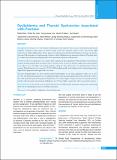Please use this identifier to cite or link to this item:
https://hdl.handle.net/20.500.14356/2316| Title: | Dyslipidemia and Thyroid Dysfunction Associated with Psoriasis |
| Authors: | Rizal, Shikha Joshi, Bishal Raj Jha, Sanjay Kumar Pradhan, Manish Regmi, Sunil |
| Citation: | RizalS., JoshiB. R., JhaS. K., PradhanM., & RegmiS. (2023). Dyslipidemia and Thyroid Dysfunction Associated with Psoriasis. Journal of Nepal Health Research Council, 20(4), 1003-1007. https://doi.org/10.33314/jnhrc.v20i4.4541 |
| Issue Date: | 2022 |
| Publisher: | Government of Nepal; Nepal Health Research Council; Ramshah Path, Kathmandu, Nepal |
| Keywords: | Co-morbidity Dyslipidemia Thyroid dysfunction |
| Series/Report no.: | Oct-Dec, 2022;4541 |
| Abstract: | Abstract Background: Psoriasis is a T-cell mediated inflammatory skin disorder which causes considerable psychosocial disability resulting in major impact on patient’s quality of life. The dominant response of Th1 cells and the high expression of related inflammatory factors appears in both psoriasis and thyroid dysfunction. Psoriasis can lead to increased risk of incidence of cardiovascular events for which dyslipidemia is an important risk factor. This study aims to evaluate thyroid function and lipid profile and its association in patients with psoriasis. Methods: This was a prospective case-control study conducted at the Department of Biochemistry, Nobel Medical College Teaching Hospital from November 2021 to October 2022. Seventy six clinically diagnosed psoriatic patients were taken as case and eighty non-psoriatic patients coming for other skin lesions were included in the study as control. Thyroid function test (serum free T3, T4, TSH) and lipid profile (total cholesterol, low density lipoprotein, high density lipoprotein and triglyceride) were done. Results: Hypothyroidism was most common thyroid abnormalities in our study population which was 13.15% (n=10). The lipid profile parameters were significantly higher in the psoriatic patients than in the controls (p<0.001). The odds of psoriatic patient having thyroid dysfunction was 2.8 times higher compared to other non-psoriatic patients and the odds of psoriatic patient having dyslipidemia was 8.7 times higher compared to other non-psoriatic patients. Conclusions: It is thus useful to assess thyroid function test and lipid profile in patients with psoriasis considering their role in etiopathogenesis and co-morbidity of psoriasis. Keywords: Co-morbidity; dyslipidemia; thyroid dysfunction |
| Description: | Original Article |
| URI: | https://hdl.handle.net/20.500.14356/2316 |
| ISSN: | Print ISSN: 1727-5482; Online ISSN: 1999-6217 |
| Appears in Collections: | Vol 20 No 04 Issue 57 Oct-Dec, 2022 |
Files in This Item:
| File | Description | Size | Format | |
|---|---|---|---|---|
| 4541-Manuscript-32187-1-10-20230720.pdf | Fulltext. | 214.36 kB | Adobe PDF |  View/Open |
Items in DSpace are protected by copyright, with all rights reserved, unless otherwise indicated.
